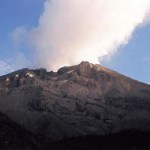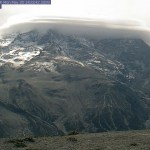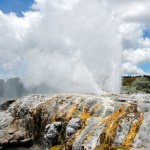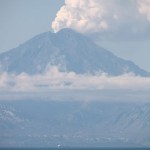volcano monitoring
We've already talked about how many active volcanoes reside in Indonesia, but this week's USGS/SI update just drives that point home. Listed in the update are no less than 5 volcanoes were activity is being seen or is on the increase (Karangetang, Slamet, Dukono, Batu Tara and Makian). This doesn't mean mention the activity at Anak Krakatau, Rinjani or Semeru. Amazing.
Anyway, highlights - not counting Indonesia or the South American trio - from this week's report (as usual aptly put together by Sally Kuhn Sennert) include:
A ~8,000 foot / 2.4 km ash and steam plume from Bagana in Papua New…
This week's edition of Wednesday Whatzits could have been called "Miércoles Materia" as all the updates are for South American volcano. Enjoy!
Tungurahua in Ecuador
(Note: all links in spanish)
INGEOMINAS in Colombia is reporting that Nevado del Huila experienced 343 earthquakes over the past week, suggesting that something is brewing at the volcano. This has been accompanied by gas emissions and ash from the fractured dome. The Volcano Observatory in Popayán mentions that more than half of the earthquakes are related to magma moving into the system. Huila remains at Level III (Yellow)…
Turrialba volcano in Costa Rica.
Turrialba, one of Costa Rica's active volcanoes, is apparently showing signs of life according to a brief report by Teletica 7 (in spanish). There is increased seismic activity and elevated gas emissions at the volcano that last erupted in 2007* and 1866 prior to that. The fumarolic activity at the summit crater is not a new occurrence, however the report implies that it has gotten more intense as the volcano has experienced increasing seismicity since early May. The Volcanism Blog does have an excellent summary of the rumblings at Turrialba since earlier in…
Fissures formed by seismicity in the Al-Ais region of Saudi Arabia. Image courtesy of Ahmed Al-Hussaini.
Although it seemed last week that the earthquakes in western Saudi Arabia were subsiding last week, there have been a number of reports that there was still significant seismicity in the area over the weekend. Earthquakes in the M2.5-3.5 range occurred on Saturday - both of which the SGS are attributing to "subterranean volcanic activity." This has prevented the evacuees from the Al-Ais region to return to their homes. The Saudi government has begun to assess how much effect this activity…
Karangetang in Indonesia erupting during the mid 1990s. Image courtesy of VolcanoWorld.
The alert level at Karangetang, one of the most active volcanoes in Indonesia, was raised to Orange over the weekend and people living near the volcano have been evacuated. The volcano is apparently already producing ash and lava flows, but it is mostly the ash hazard that is prompting the evacuations. Karangetang erupts almost every year and sometimes with deadly consequences, as in 1992 when 6 settlers near the volcano perished.
Redoubt steaming away on May 4, 2009. Image courtesy of AVO/USGS
Fairly quiet weekend (except for the start of the College World Series regionals ... I do have a favored team*), volcanically speaking, but the ever-vigilant folks up in Alaska are keeping an eye on Redoubt as the eruption of 2009 continues.
The weekly status (released 5/29) for Redoubt released by AVO has no big surprises, reporting that "small discrete earthquakes and rockfall signals in the summit region have been recorded steadily over the course of the past week. In other words, the dome continues to extrude and part of it…
Here's some news bits for all you volcanophiles. Enjoy the weekend!
Ubinas in Peru steaming away in June 2007. Image courtesy of Eruptions reader Mike Lyvers.
There has been a lot of press lately on the theory that a large eruption from an ancient volcanic field in China (the 260-million-year-old Emeishan volcanic province of southwest China) could be the culprit in the grand Permian extinction. I have to admit, I've only skimmed the surface of this study, but the work lead by Dr. Paul Wignall (a paleontologist, not a volcanologist - not that there is anything wrong with that) seems to…
You'll have to excuse the curtness of this post. An bad hop in softball will do that to you.
Here's some news:
Mt. Dempo in Indonesia
Xinhua offers some nice pictures of the current activity going on at the summit crater at Nyiragongo in the Congo. Note the partially-crusted-over lava lake in the first shot. The Red Cross is updating the evacuation and mitigation plans for the area as the volcano shows increased activity.
The alert level at Mt. Dempo in Indonesia was raised to the second highest level. There has been ash fall (as far as 10 km from the vent) and volcanic gas emissions. The…
Lenticular clouds forming over Redoubt on May 25, 2009. Image courtesy of AVO/USGS and sent to me by Eruptions reader Todd Russell.
We haven't talked much about Redoubt lately, so I thought I'd add a brief update. First off, the Alert Level at the volcano still sits at Orange/Watch status, meaning that although the volcano is not erupting, it could at almost any time.
Most of the threat of eruption stems from the ever-growing lava dome on the volcano. AVO noted today that the "Hut webcam views today show evidence of recent rockfall activity, including a fresh ash deposit to the east (left)…
Al-Qider volcano in western Saudi Arabia. Image courtesy of Ahmed Al-Hussaini.
After a week's worth of worry, it appears that the seismicity in western Saudi Arabia is subsiding. The latest statement from Zuhair Nawab, the head of the SGS, is that over the past four days with fewer and less severe aftershocks. If this continues, people who have evacuated the area around Al Ais might be able to return to their homes in a few days. However, it is important to note that even though officials suggest the seismicity is waning (and there may be indications this is not entirely accurate), the swarm…
Pohutu Geyser in Rotorua, New Zealand. Image taken by Erik Klemetti in January 2009.
It has been busy busy week for me, capped off today with a talk about my field work in New Zealand (see above), so I don't have much to say. Not much new news today about the Saudi Arabian earthquake swarms, but again, I'll keep my eyes pealed (incidentally, I still haven't been able to figure out why no western news sources have even mentioned the swarm).
Anyway, here's are some volcanic tidbits to enjoy over the long weekend:
Vog, as seen from space. Volcanic fog, fashionably shortened to "vog" is a real…
UPDATE 5/21/2009 4:30 PM Pacific: The latest news suggests that there are little to no evidence of volcanic gases since Wednesday according to the SGS, but they continue to monitor.
Lava flows from a 1256 A.D. eruption near Medinah in Saudi Arabia (to the south of Harrat Lunayyir) taken by the crew of the ISS in 2004. It shows nicely the volcanic heritage (dark lava flow on right of image) in western Saudi Arabia. Image courtesy of JSC Earth Observation Lab.
Well, as the days go by, there are more and more indications that an eruption is about to occur in the Harrat Lunayyir region of Saudi…
A week's worth of volcano news in one sitting, thanks to the USGS and Smithsonian Inst.'s Global Volcanism Program.
Thanks again, Sally Kuhn Sennert for putting it together!
This week's highlights include:
Small ash column spotted at Manam, Papua New Guinea. We talked about Manam not too long ago.
More details of the ongoing submarine eruption at West Mata in the Mariana Islands.
The lava dome continues to grow on Redoubt, Alaska with no real collapse yet.
Pilots spotted small (2.1 km / 7,000 foot) steam/ash plumes at Suwanosejima, Japan.
5-6 km / 18-25,000 foot ash plumes were produced by…
I have finally gotten together enough to create a Google Earth image (below) of the location of the Saudi Arabian earthquakes and their depths/magnitudes. I only have the data from the USGS earthquake list, but it is very illuminating:
Harrat Lunayyir volcano in western Saudi Arabia from Google Earth with the current earthquakes shown on the image. Image courtesy of Google, earthquake data from the USGS. Click here to see a larger version.
The earthquakes look like this (all times are Universal Time):
Date Time Mag. Depth
5/17 19:50 M4.6 10 km
5/19 06:38 M4.9 10 km
5/19 16:54 M4.9 10 km
5/19…
Al-Qider volcano in western Saudi Arabia. Image courtesy of Ahmed Al-Hussaini
The intense seismicity occurring underneath the Al-Eis region in Saudi Arabia has reached a point where Saudi Arabian officials are requiring 60,000 people who live in the region to evacuate. This is after M4.6 and M5.4 earthquakes that occurred Tuesday night (Saudi time). Saudi officials have also begun to build shelters for people affected by the earthquakes.
Now, the direct connection to a potential eruption is still very much in the air, but the earthquakes are still centered underneath known Holocene volcanic…
El Misti in Peru, as seen from Arequipa.
As I like to remind people concerning volcanic hazards, an ounce of prevention is worth a pound of the cure. This is not to imply we can prevent volcanic hazards from affecting us, but rather that proper mitigation in the form of monitoring, planning, education and practice can save countless lives (and dollars) when a volcano erupts. Officials in Peru seem to believe this, as they recently ran for practice evacuations for residents around El Misti, in the southern part of the country. Jersy Mariño from the Instituto Geológico, Minero y…
Volcano news ahoy, today brought to you by Islands.
Lake Kivu, located along the border the Democratic Republic of the Congo and Rwanda
A gorgeous satellite image (brought to us by the NASA EO) of a steam plume and ash from the ongoing eruption at Shiveluch in Kamchatka. The ash distribution stands out remarkably well on the white snow, with the central circle of ash near the vent/dome and then the wind-aided ash blanketing the terrain to the northeast of the volcano (and a little bit to the south).
Nature has a post reminding us that one of the big hazards at Nyiragongo/Nymuragira is not…
The Harrat Khaybar volcanic field in Saudi Arabia. Image courtesy of NASA, taken in 2008.
Now, I might take this report with a Volvo-sized grain of salt, but I've seen a few reports lately of an earthquake swarm going on in Saudi Arabia, near the Harrat Ash-Shaqqah in Al-Eis region (apparently near Madina, but I'm not 100% sure). I might normally just chalk this up to the tectonics of the Arabian Plate, however, the latest article I read this morning, Saleh Al-Muhawis, Director General of the Civil Defense in Madina Region mentioned this as the cause of the seismicity:
... magma (molten…
Here's the latest news from the USGS and SI Global Volcanism Program. It might not record every little volcanic noise in the world each week, but nothing like getting all the major volcanic events summarized on a weekly basis.
Highlights this week (not including Nyiragongo, Redoubt and Galeras):
The eruption at Rinjani in Indonesia continues, with elevated seismicity and 300-600 meter plumes.
Sporadic strombolian eruptions from the Crater C at Arenal, Costa Rica (since late April)
High seismicity, 100 meter domes and continued dome collapses continue at the two domes growing at Chaiten,…
Redoubt emitting a large steam plume in April 2009. Image courtesy of Calvin Hall.
A few snippets from the world of volcanoes:
The current eruptive cycle at Galeras continues to go strong. Officials with INGEOMINAS, the Colombian Geology Survey, believe the volcano will erupt again in the next few "days to weeks". The volcano last erupted a few weeks ago (in spanish) and caused quite a bit of panic in the city of Pasto at the foot of the volcano. An Orange Alert has been issued (in spanish) for the volcano.
Another volcano have is on the verge of a larger eruption is Nyiragongo in the DR of…





